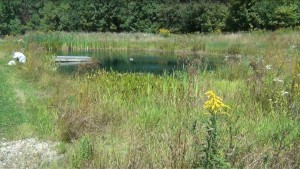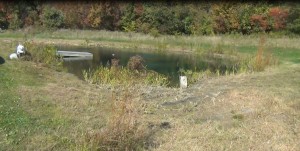As we look outside, we see the leaves changing, cooler temperatures and those fall clouds, sadly it is a reminder that the Pond Season Is Almost Over. What can we do to get the pond ready for winter?
First up is all the growth around the pond, plants and weeds both need to be cut back. Mostly the plants and weed in the pond that will die over winter that will become more muck and nutrients next year. The most important weeds and plants to be concerned about are the submerged plants, once the ice and snow covers the pond they’ll begin to die and sink to the bottom of the pond.
For the perimeter plants along the shoreline, looking at the cattails and bulrush we may want to wait until next spring to get last years growth and get the mass out of the pond. Why wait? If you are using these plants as a erosion control you won’t want to cut them until spring since the stalks or stems are rather tough they can withstand the snow and provide some wave diffusing during the spring storms. The images is our little pond and there is no need to worry about erosion since we have the side slopes are very gradual.
The Fall Leaves are another problem for the pond. Sure they look great reflecting from the water surface but when they fall into the pond or get blown into the pond, we have just accumulated more nutrients and muck for next season. Did you ever notice ponds in the woods or surrounded by trees have a tea colored appearance to the water, this is from the leaves tinting the water and yes the pond could look black, brown or other colors from tint in the leaves.
Smaller water gardens and Koi Ponds may be a little easier to protect form the leaves by adding a net over the pond.
What about pond equipment like the fountain and aeration system? Sure I’ve seen folks leave their fountain run all winter, moving water won’t freeze right? What happens when the power goes off? I just don’t want to take that chance, besides this is a fairly good sized investment why take chance.
The aeration system can be left out doors if it is in a cabinet and or protected from the elements. If you should decide to leave it run during winter to allow toxic gasses to escape, move the diffusers to half the depth of the pond. So if your pond is 10′ deep move them to an area that is 5′ deep. The reason we do this is to prevent super cooling of the pond which could harm the fish.
Another reason to run a the aeration system is to protect the doc from heaving from the pond ice, once the dock or deck in our case is lifted it may not drop back down and you’ll have uneven surface if that happens. In the video Aerator Start up we cover this in more detail.
These are the main items to look at once the season starts heading to winter.
- Keeping the main or most of the mass of plants from becoming muck and nutrients.
- Winter aeration to keep a hole in the ice allowing toxic gasses to escape and provide oxygen from the diffuser and open water.
- Open water to protect decks and docks
- Open water for water fowl
If we have a winter as we did last year with no mid winter melting of ice, more fish kills can be expected.
Need help deciding on what aeration system you need for winter aeration or for properly aerating your pond year round let us know by using the contact page.




Comments on this entry are closed.
Great article, I especially appreciate the advice about setting the aerator to half depth. I’ll definitely do that before it gets much colder around here.
Thanks Ron, Just getting a little head start on the season change. The general rule of thumb is to turn off or move the diffusers when the water drops to 50-55 degrees.